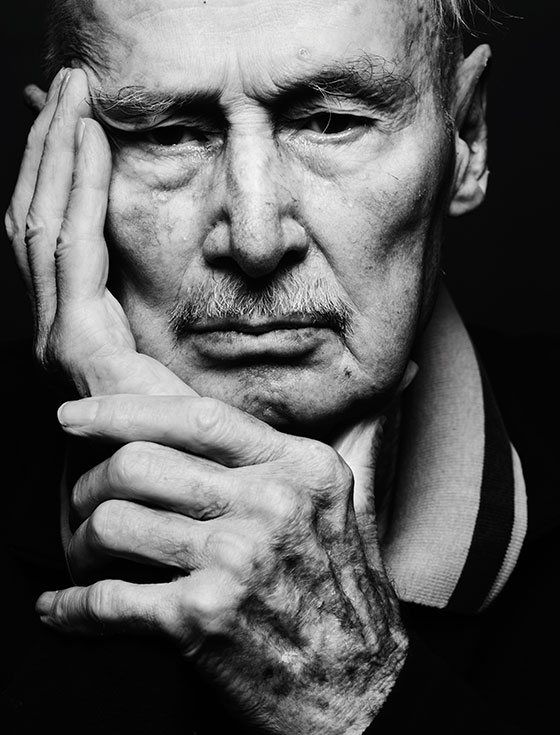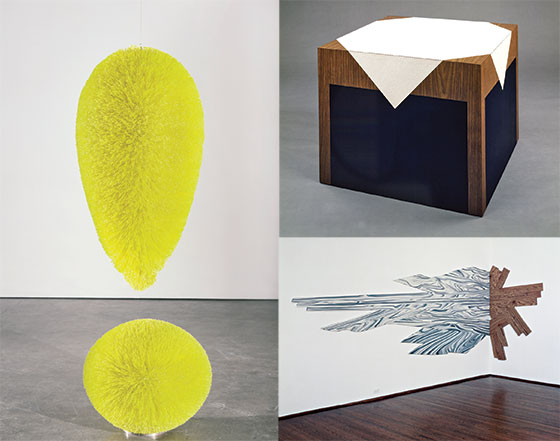
On my way up to Richard Artschwager’s Chelsea apartment, I’m being briefed about the air-conditioning situation. He likes it a bit on the balmy side, Yale University Art Gallery curator Jennifer Gross tells me as the elevator rises. It reminds him of his New Mexico youth.
That youth, of course, has long since passed: Artschwager will turn 89 in December. Yet in his advanced age, inclinations toward the distant past, toward what might be deemed his natural habitat, seem to have manifested themselves in new ways. The mountainous vistas from his childhood (and his earliest art-making days) have reemerged in striated color pastel compositions on paper, some of which are intersected by empty roads that vanish into the distance. It’s a departure from the work for which he’s best-known: the wry-funny Formica-sheathed sculptures of furniture, and his grisaille paintings on Celotex, a fibrous white board used primarily for insulation.
Artschwager rises to greet us as we make our way into the modest one-bedroom he shares with his wife. Their living-room walls are lined with works by both the artist himself (a Formica sculpture resembling a tall, skinny piano; an abstracted 1962 acrylic-on-Celotex that looks like a plowed field) and others, many of them friends and fans (Ed Ruscha, Albert Oehlen). He’s chatty and convivial, for the most part, as we discuss the full-career retrospective, curated by Gross, that opens at the Whitney on October 25. But on the subject of his work he takes long, deliberate pauses to formulate his thoughts (longer than he’d like, from the looks of it). He’s keen to discuss what motivates him, especially after all these years, and the conflicts that have driven him from the get-go. “My most important quality or property is curiosity,” he says. “And that had its beginning in what I was going to do with my life. To paraphrase my father, ‘Are you going to be an artist or are you going to be a scientist?’ ” He was, essentially, reared by one of each—his mother was a hobbyist painter, and his father was a biologist who worked with plants.
Artschwager picked science first, studying biology at Cornell before and after serving in World War II. Yet the very act of pursuing science (plus some coaching from his first wife) caused him to veer in the other direction. “All the good stuff had been done. Einstein, he’d gotten it all! He didn’t leave us anything!” Artschwager says. “But I saw some gaps in art. That’s where things were left undone, in a mess. The people doing it seemed to be trying to use their souls.”
Art might have prevailed over science, but Artschwager’s approach was no less diagnostic. “The first thing I needed was the definition of art,” he says. “And I came on that right away: Art is useless-looking, its activity or production to no purpose, certainly not to make a living. I would wake up at night and think, What the hell have I gotten myself into? You don’t want to do that! But you gotta do something, and with art, there’s freedom—which is actually very seldom practiced by artists. We’ve got this and this and this,” he says, gesturing to his five senses, “and that’s it! And it’s enough just to use them. Or to play with them.” Or, ostensibly, to turn them on their heads. As he wrote in one of his notebooks in the early sixties: “Sculpture is for the touch, painting is for the eye. I wanted to make a sculpture for the eye and a painting for the touch.”
Discovering the potential in weird art materials was critical. Formica, he tells me, is “pictures partially complete”—it brings its premade color fields, patterns, and sheen. Likewise Celotex, the bumpy, cardboardy surface on which he has painted some of his best-known works (grayish and abstracted renderings of photographs, some plucked from newspapers): “The drawing is already partly there—it’s in the paper. And the paper is talking before you do.”
Over the years, Artschwager’s oeuvre grew to include Formica-covered riffs on tables, chairs, mirrors, and other pieces of everyday furniture; black ovular “blps” that adorned city streets and gallery walls (a selection of which will speckle the High Line during the retrospective this fall); figural reliefs crafted out of rubberized hair; and expertly built wooden shipping crates scattered around a gallery’s white cube as sculptures themselves. “That he can be considered a minimalist, a conceptualist, and a Pop artist means that he is none of those things,” Gross says. It’s also why, perhaps, his work is not quite as well known as, say, Ruscha’s or Richard Serra’s. “He has made things that are confounding on a regular basis—his driver has been his own creativity and the freedom to do that.”

I ask him about New Mexico’s recent reappearance in his work. “That’s nostalgia,” he says. “That’s where I come from.” He points at his living-room window’s interior-courtyard view, the kind of limited vista that would send most country boys screaming back home. “I’ve adjusted to that. But once in a while I feel the time falling by, and [I think], What the hell am I doing here? I visit [the Southwest] every so often, but not often enough. It clears my head.”
There’s another reason that Artschwager might be experiencing a touch of New York City malaise. He and his wife, Ann, recently sold their primary home, a converted church in Hudson, New York. (They kept a small live-work space upstate in what used to serve strictly as Artschwager’s studio, and converted that into their main living space.) They’re hoping their streamlined life will free them to travel and spend more time in the Southwest. “That atmosphere, that climate—it’s all poetry,” he says. “One’s appetites are for anything—for this moment. I’m not a kid anymore, and I can see the clock is ticking. That’s what pushes me now.” Besides, he adds, “I’m not married to anything except for my wife.” Over and over, as we speak, he cites Freud’s “pleasure principle,” the insistence that the id’s primary motivation is to avoid its natural state of pain. It’s his primary motivation now, he says, and it’s what he hopes to communicate at the Whitney: “It’s a chance to see a body of work and make some pleasure for other people. You can make pleasure for oneself, but there is pleasure in making pleasure for other people too. There isn’t any art until some creature sees and consumes it. And has a reaction.”
Richard Artschwager!
Whitney Museum of American Art
Opens Oct. 25